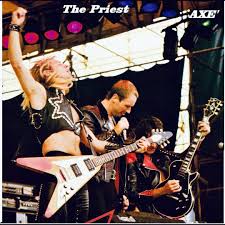Backstage Glimpse: 1980 British Steel Tour with K.K. Downing, Ian Hill, and Rob Halford….,…
In the pantheon of heavy metal history, few tours are as iconic and influential as Judas Priest’s British Steel tour of 1980. Propelled by the success of their groundbreaking album British Steel, the band—at the peak of their powers—hit stages across the UK and North America with an electrifying energy that would go on to define a generation of metal. Now, more than four decades later, newly uncovered photographs and backstage recollections have reignited interest in what many fans and critics call the golden era of Judas Priest.
At the heart of the tour were guitarist K.K. Downing, bassist Ian Hill, and frontman Rob Halford. Each member played a critical role in the band’s sound and stagecraft, combining theatricality with thunderous musicianship. A recently unearthed set of behind-the-scenes images taken during the British leg of the tour offers an intimate glimpse into the personalities behind the power chords and high-pitched wails.
K.K. Downing, known for his flying V guitar and dynamic stage presence, is captured in moments of quiet focus backstage, meticulously tuning his guitar before taking the stage. In interviews from the time, Downing described the tour as “the moment when metal found its swagger.” He played a key role in crafting the razor-sharp riffs that defined tracks like “Breaking the Law” and “Living After Midnight,” which became staples of their live shows and anthems for the burgeoning metal community.
Ian Hill, often referred to as the “anchor” of Judas Priest, is shown in candid shots sharing laughs with road crew and bandmates, revealing a more relaxed side of the typically reserved bassist. Hill’s tight, pulsing bass lines held down the rhythm section throughout the tour, providing the crucial foundation for Downing and Glenn Tipton’s dual guitar assaults. Despite being one of the quieter figures in the band, Hill’s consistency and dedication were vital to Judas Priest’s success and their tight live performances.
Of course, no account of the British Steel tour would be complete without mention of Rob Halford, the “Metal God” himself. Clad in leather and studs, Halford’s theatrical entrances—often riding a Harley-Davidson onto the stage—became legendary. The backstage footage reveals a more contemplative side to Halford: warming up his operatic voice, reflecting on the meaning behind the band’s lyrics, and mentally preparing for the high-octane show ahead. In later interviews, Halford described the British Steel era as a “time of creative liberation” for the band, noting that the album and its tour marked their transition from cult heroes to global metal icons.
Released in April 1980, British Steel was a pivotal album not just for Judas Priest, but for heavy metal as a whole. It stripped away some of the more complex arrangements of their earlier work and introduced a more direct, aggressive style that resonated with fans around the world. The tour that followed took them to packed venues, where the roar of Marshall amps and the chanting of fans turned each night into a thunderous celebration of rebellion and raw power.
The backstage life, as shown in these new glimpses, was a blend of intensity and camaraderie—grueling schedules, practical jokes, moments of solitude, and bursts of euphoria. It was also a testament to the band’s commitment to their craft. Despite the pressures of fame and the rigors of the road, Downing, Hill, and Halford remained steadfast in their mission to deliver the most powerful performance possible, night after night.
Today, as metal continues to evolve, the British Steel tour remains a towering milestone in its history. For longtime fans, these behind-the-scenes insights serve as a nostalgic reminder of a defining moment in music. For newcomers, they offer a glimpse into the soul of a band that helped shape the sound and spirit of metal for gener
ations to come.
